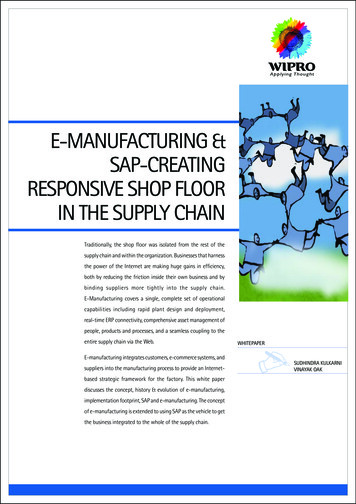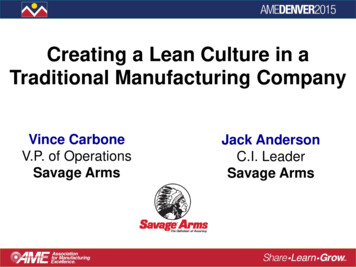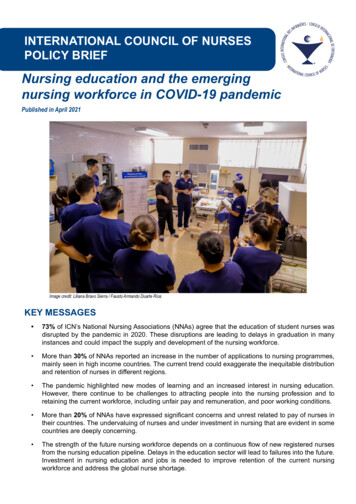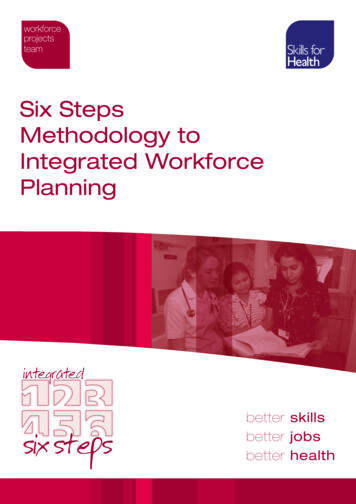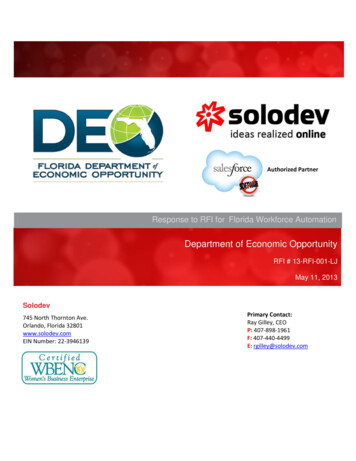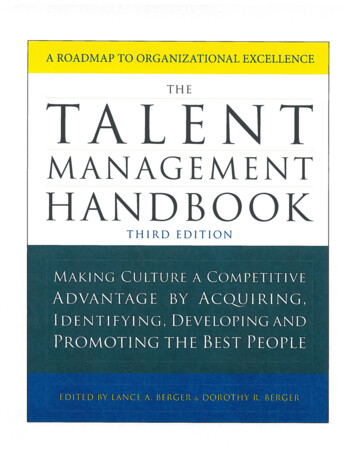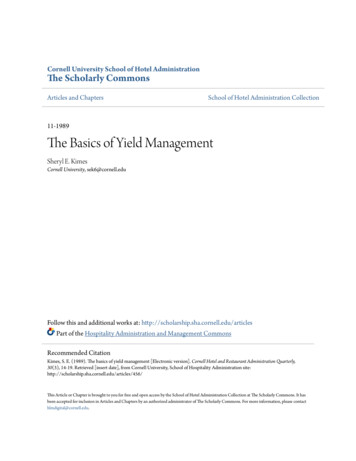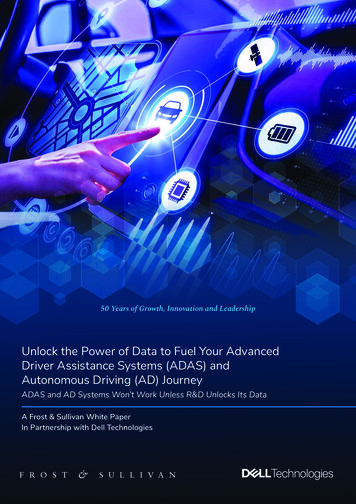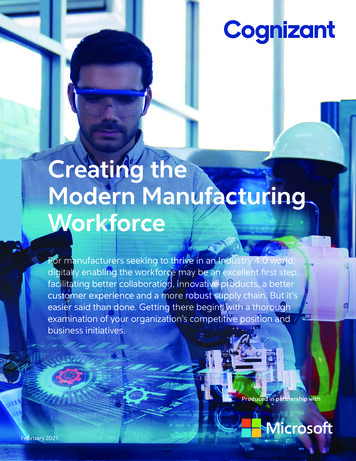
Transcription
Creating theModern ManufacturingWorkforceFor manufacturers seeking to thrive in an Industry 4.0 world,digitally enabling the workforce may be an excellent first step,facilitating better collaboration, innovative products, a bettercustomer experience and a more robust supply chain. But it’seasier said than done. Getting there begins with a thoroughexamination of your organization’s competitive position andbusiness initiatives.Produced in partnership withFebruary 2021
Executive SummaryEven before COVID-19 hit, manufacturing faced pressure to upits digital game. The industry’s very maturity was sometimesperceived as working against it. Competing with tech, financeand other sectors for young talent was growing more difficult.Fairly or not, manufacturers had a reputation for stodginessand reluctance regarding investing in the technology thatexcited top millennial minds. Meanwhile, global competitionwas relentlessly driving down price points and profits ontraditional goods.The onset of the pandemic highlighted the industry’s vulnerabilities. Supply chains, whichhad long been built on a low-cost-at-all-costs approach, were exposed as overly relianton a single region. While workers in many industries needed only a phone, a laptop andcollaboration software like Microsoft Teams to resume work, many manufacturers shut downfor extended periods, their shop floors and assembly lines at the mercy of broken supplychains, distancing guidelines and other imperatives.So if the writing was on the wall before COVID-19, the pandemic has added underlining andan exclamation point: Manufacturers that haven’t done so already must embrace digital –and fast.But where to begin?All too often, enterprise attempts at digital business take the form of technologiesassembled in haphazard fashion, with no unifying vision. Initiatives along these lines tendto further complicate existing process execution. Unsurprisingly, they usually fall short ofcomprehensive business model change.The modern enterprise construct offers manufacturers a way to think of their operationsholistically, using a quantifiable business-centric approach that provides a context forreimagining core processes; supporting technologies; and organizational and culturalmodels needed across the value chain. It thus puts into perspective key trends andimperatives, such as the merging of the physical and digital worlds, the democratization ofdata, and the linchpin: workforce transformation.2 / Creating the Modern Manufacturing Workforce
A 2019 study by Cognizant’s Center for the Future of Work indicates that employeesgenerally considered blue-collar feel that they lack the right technology to do their job1and are subject to fragmented experiences, outdated processes, and legacy technology.Closing the skills gap, retraining the existing workforce, and building a data-driven cultureare fundamental to workforce transformation in manufacturing. Moreover, they are alsofundamental to becoming a modern manufacturing enterprise, which entails embracingagility and resilience and democratizing data in a holistic effort to eliminate silos andrespond to customer needs. (Learn more in “Crafting the Modern Manufacturing Enterprisein the Post-COVID-19 World.”) For this reason, workforce transformation may be an idealstepping stone in the larger shift to Industry 4.0 — but that’s true if, and only if, it is donewithin the context of what the business’s needs are as they pertain to its value chain. 2In this white paper, we highlight recent examples of engagements conducted by bothCognizant and Microsoft that reveal the key architectural and operational principles criticalfor moving the manufacturing workforce into the digital age. They include attracting andmanaging talent; enhancing skills, productivity and teamwork; connecting the workplace;and delivering innovation that drives true business value.Manufacturers considering this path should begin with an evaluation of the company’sexisting technology footprint and business processes in light of new initiatives, and shouldgo where the evidence leads them; workforce enablement will be the appropriate path formany, but not all, organizations.The modern enterprise construct offers manufacturersa way to think of their operations holistically, using aquantifiable business-centric approach that providesa context for reimagining core processes; supportingtechnologies; and organizational and cultural modelsneeded across the value chain.Creating the Modern Manufacturing Workforce / 3
The COVID-19 impactThe pandemic has highlighted the importance of staying connectedregardless of physical location, although the trend toward increasedwork from home (WFH) and reduced factory-floor personnel wasalready solidly in place.Despite COVID-19’s tragic, world-twisting nature, then, the pandemic offers clarifying insights formanufacturers. Businesses that are rethinking aspects of their processes due to work from home (WFH),geographically distributed employees and so on are grasping the importance of versatility in workers.Manufacturers need people who can learn multiple advanced technologies, learn them quickly, train others intheir use and embed them in day-to-day processes to create value. This aggravated an already growing skillsgap across the industry, as illustrated in Figure 1.Trends shaping the workforce transformation agendaTechnology, competition and globalization are reshaping the manufacturing industryClosing the skills gapEmpower your workforceReskilling the existing workforceDeliver new servicesEmpowering first-line workersAddressing an evolving dynamic work environmentMarketopportunitiesOptimize digital operationsBuilding a data-driven cultureConsidering rising security & compliance concernsFigure 14 / Creating the Modern Manufacturing WorkforceReimagine manufacturing
Attracting the next generationExcelling in the future will require employees with top digital skills, and this is an area in which investing inworkforce technology could provide a boost. Manufacturing is one of the most established industries in today’sbusiness landscape, with many processes that date back 100 years or more. On the positive side, this meansmanufacturing processes and guiding philosophies have been honed and fine-tuned through extensiveexperience. On the other hand, manufacturing’s long history and pragmatic nature don’t exactly add to its sexappeal, in a workplace context. In general, manufacturing faces “an acute skills gap,” and clients tell us that thisis exacerbated in the digital arena, with top tech minds applying their talents to other industries. 3One way that manufacturing can address this gap is to match the tech offerings that appeal to not onlymillennials, but also workers of all ages who are eager to embrace the latest tools. Consider collaborationand meeting apps now taken for granted, such as Microsoft Teams, Slack and Zoom. Not long ago, Slackwas scoffed at by old-school manufacturing enterprises, deemed a departmental toy that was not ready forprimetime. Today, it’s hard to imagine functioning without Teams or a similar tool. (To learn more about thetype of project, tools and mission that can attract millennials, see Quick Take, on the next page.)Creating the Modern Manufacturing Workforce / 5
Quick TakeBreathe in: Tackling theventilator shortageAs the effects of COVID-19 were felt around the world, leaders at the UK’s High ValueManufacturing Catapult, which is tasked with boosting tech innovation, sought to addressthe UK’s shortage of hospital-grade ventilators. The resulting VentilatorChallengeUKconsortium demonstrates the best values and abilities of today’s manufacturers and digitallycapable workforce.For such an extraordinary mission, Microsoft ensured rapid deployment of its HoloLens,the Microsoft Azure cloud platform, Teams, Dynamics 365 and Power BI to the consortium.HoloLens, a mixed-reality headset, serves as a powerful example of tools enabling workforcetransformation. It allowed assembly line staff to see holograms of how parts fit together andmake hands-free video calls to experts while they were working. Through voice commandsand hand gestures, they could bring up a virtual screen that hovered in front of them,displaying a live stream of someone with knowledge of the ventilators, wherever they werein the world. That was critical for 2,500 engineers who had spent their careers buildingproducts such as cars but now had to switch to assembling medical equipment overnight.(Mixed- and virtual-reality tools have also become valuable for workplace training in general,and safety training in particular.)Additionally, Azure Cognitive Search lets workers create a digital repository of information;pictures; video; and handwritten and typed documentation, and then retrieve informationrelevant to the job at hand.With these tools in the hands of a digitally enabled workforce, the consortium established anew supply chain; performed all necessary training; and thus was able to scale productionfrom 50 ventilators a week to 1,500 a week — compressing what would typically beconsidered a two-year project down to two months.6 / Creating the Modern Manufacturing Workforce
The new workplaceAs it’s been noted often since COVID-19 hit, remote management andcollaboration will remain key parts of working life going forward. WFHand reduced human presence on the factory floor is hardly new; whatis now clearer than ever is that manufacturers must keep investing intechnology and talent to maintain productivity, preserve corporateculture and drive professional development.On the collaboration front, environments like Microsoft Teams have quickly become a household word. Goingforward, manufacturers need tools that deliver a consistent feature set and user experience regardless ofplatform and physical location. Glass packaging producer Owens-Illinois (O-I), which has 26,500 employeesin 77 plants across 23 countries, upgraded from Skype for Business Online to Teams and quickly discoverednot only new capabilities that O-I knew it needed (notably improved communication and decision-makingwithin its glass production processes across both shifts and device types), but also some capabilities thatcame as a pleasant surprise, such as real-time language translation in instant messaging. Almost immediately,employees began to use Teams’ built-in translation capabilities to support communication in their languageof choice.Early in the COVID-19 lockdown, emotions ran high throughout the corporate world, suggesting that many,perhaps most, organizations would not permit workers to return to a physical work environment anytimesoon. WFH productivity was said to be at least as high; the future of office parks was deemed dire.The passage of time has led to a more mixed reality, especially where manufacturing is concerned —despite the march of technology, the shop floor still tends to require a large number of people, often inclose proximity to one another. Moreover, studies find that while WFH does bring certain benefits (personalcreativity, ability to focus) to many employees, most people want to get back to their physical workspace.4For a look at how Cognizant is enabling a safe return to the factory or office, see Quick Take, page 8.Creating the Modern Manufacturing Workforce / 7
Quick TakeGetting back to the shopfloor – safelyThe Cognizant Safe Buildings approach combines layered safety strategies and atechnology foundation to sense, monitor and manage data insights to lower risks. 5Tools and strategies help manufacturers: Screen employees and visitors for elevated body temperatures using thermalimaging. Monitor physical distancing and provide contact tracing through location data fromwearable sensors, smart cameras and systems. Ensure hand hygiene and sanitization compliance using data from smart bands.One of many early adopters, a multinational food company with 150 factories and100,000 employees piloted Cognizant Safe Buildings with the goals of trackingworkers’ physical distance from one another; sending alerts on violations of thesedistancing rules; and contact-tracing employees who’d been exposed to COVID-19.The pilot was a strong success, according to the manufacturer. Following tweaksdeveloped through employee feedback, the program is now being scaled first to themanufacturer’s North American factories, and then to other geographies.In keeping with our suggested approach of auditing business needs and allowing themto dictate the best action, manufacturers should consider their own situation beforerushing employees back to the shop floor en masse. WFH is now commonplace. Thegoal is not necessarily to gather the largest possible group under one roof, but ratherto preserve productivity and organizational culture while enabling workers who mayspend only part of their time in an office or on a factory floor.8 / Creating the Modern Manufacturing Workforce
The new workforceWhen manufacturers audit their technology and business initiatives toration alize investment, they often find that reskilling their workforce earnsa high priority. As a 2019 report from Cognizant’s Center for the Future ofWork put it, “blue-collar work isn’t what it used to be.”6 Consider, the authorsnoted, today’s factory floors, layered with sensors and algorithms sequencing intricate hand-offs between teams of people and banks of machines.In such environments, newly empowered workers aren’t limited to routinephysical tasks; armed with the ability to exploit data, analytics or machinelearning, they’re adding value in innovative ways, using human insight andjudgment to master sophisticated technical process work with skill and flair.This new category of worker is exemplified by the “Takumi Masters” at Lexus, who meld detailed knowledge of digital processes with old-school experience and an artisan’s touch.7 At Lexus, to be a Takumi is to have earned a highhonor — and to be rewarded appropriately. We believe this is the evolutionary direction of what we’ll call the DigitalCraftsperson.For another example of thoughtful workforce enablement, this one focused on field technicians, see Quick Take,page 11.Unfortunately, not enough enterprises are creating environments in which digital craftspeople can thrive, in spiteof a clear need, as shown in the following figure; this is the type of investment that a careful self-assessment canlead to. Failing to prime the workforce is a severe risk. The technology isn’t slowing down, and the competitivepressure is only going to ratchet up. The time to act is now.Creating the Modern Manufacturing Workforce / 9
Quick TakeWhat color is your collar?A Cognizant Center for the Future of Work research report found less than half ofbusinesses across industries were making needed workforce strategy changes despite: Over 70% of respondents say the biggest driver impacting blue-collar work is the growthof technology. Blue-collar work will focus less on physical, repetitive tasks and more on knowledgeintensive, digital-oriented roles. The use of smart machines is predicted to rise over the next five years for routine andsimple decision-making, by nearly 26% and 35%, respectively, and even more so forcomplex and mission-critical decision-making (44% and 75% increases, respectively). Nevertheless, most operational decisions will still require lots of human input. A productivity bonus awaits leaders — businesses that consider themselves ahead ofthe competition in this area expect a productivity kicker of 13% to 14% over the next fiveyears.10 / Creating the Modern Manufacturing Workforce
Quick TakeEnabling field techs:Efficiency’s going up, costs aregoing downWith WFH and the field now a virtual extension of the factory floor, enabling remote workershas never been more important for manufacturers. Recently, one of the world’s largestelevator OEMs sought to improve the productivity of its more than 31,000 field technicians.Cognizant, selected as the manufacturer’s mobility enablement partner, performed anactivity analysis and found that fully 40% of the technicians’ work was considered to be oflow value. The first step in reducing this percentage was to put in place key performanceindicators (KPI) to ensure all changes contributed to business goals — to wit, improvedproductivity.By codifying cumulative expert input as knowledge graphs in Microsoft Azure, Cognizantcreated first a troubleshooting app featuring search and chat capabilities, and then a toolthat actively monitors the company’s elevators at scale.Results? Immediately, average search times for parts dropped from 10 minutes to 2, theclient told us. Little wonder, then, that the initiative that continues to be rolled out hasachieved a 5% improvement in field-tech efficiency — or a 300 million per year savings –according to the client.
Quick TakeThe manufacturing value chain: Future capability mapIndustry 4.0AI assistantfor employeesIntelligenttraining deliveryMixed realitydriven L&DCross-functional &organizational level groupsR&DTransforming the future ofproduct development andengineeringUnlocking hidden valuethrough digitalShopfloor visibilityDigitalasset managementOperationsintelligenceRealizing the industry 4.0 visionPredictive maintenanceIntelligent supplychain planninge-auctions for delivery(continuous RFP process)The next-generationdigital supply chainNo touchorder processingDigital order platformHigher sales productivity andcustomer experiences acrosschannelsEcosystemcollaboration platformas-a-serviceHyper-personalizationservices and solutionsFigure 212 / Creating the Modern Manufacturing WorkforceDuring service innovation
Rethinking dataThe democratization of data demonstrates how changes made with theworkforce in mind can and should filter up through the organizationto deliver value in myriad ways. Through data lakes or other means,forward-looking manufacturers are creating a “single source of truth”so that workers across departments — customer service, operations,finance — can maintain consistency, confident that they’re all singingfrom the same hymnal.Before it can be democratized, data must be modernized; data in older formats doesn’t lend itself to webservices-enabled forms of interoperability and sharing across silos, business functions and ecosystems.Once addressed, data modernization does far more than enable employees. Properly aggregated, data is fareasier to store, use and share. That allows businesses to transform what was once an expensive burden intoan asset that helps leaders drive revenue growth, contain costs and increase business value.Tooling and industrial materials supplier Kennametal, based in Pittsburgh, operates globally in multiplelanguages, solving problems for customers in different verticals and regions. Kennametal employees arenow using Microsoft Power Platform to gain insight into factory productivity, using dashboards to get aheadof the curve on incidents and equipment issues that previously required expert-level human resourcesonsite. Natural-language query capabilities, whose results are presented in easily digested visual formats,will ultimately provide 12,000 employees in multiple geographies with cloud-based access to sophisticatedanalytics and project data. Visualizing information in minutes, business users can explore data and uncovernew insights without specialized help, Kennametal said.In a prime example of how workforce empowerment benefits the business as a whole, Kennametal’s broadervision is to link its smart factories to customers, providing them with up-to-the-minute information.Once addressed, data modernization does far more than enableemployees. Properly aggregated, data is far easier to store, useand share. That allows businesses to transform what was once anexpensive burden into an asset that helps leaders drive revenuegrowth, contain costs and increase business value.Creating the Modern Manufacturing Workforce / 13
Lookin
collaboration software like Microsoft Teams to resume work, many manufacturers shut down . primetime. Today, it’s hard to imagine functioning without Teams or a similar tool. (To learn more about the . products such as cars but now had to switch to assembling medical equipment overnight.



